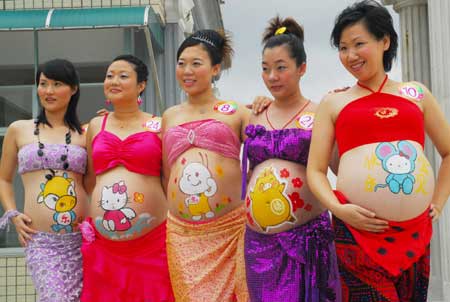| Home > Living in China > Art |
Art Journey to the East
China and Japan have had a long relationship since the Han Dynasty. In the same manner that Monk Jianzhen’s east journey, brought to Japan Buddhism, traditional Chinese medical science, architecture, painting and calligraphy skills, implements and artworks were also shipped to the land of the rising sun in addition to ceramics.
The Museum of Oriental Ceramics, Osaka, as its name suggests, is a museum dedicated to collecting, exhibiting, and researching oriental ceramics. The strength of Chinese ceramics in the museum’s collection lies in the Tang, Song, Yuan, and Ming dynasties, exactly the period during which ceramic art enjoyed its most brilliant successes as it grew to full maturity. Although it is not large in scope, the collection has important works representing each period and results in a collection of remarkably high concentration, one which indeed may be called a “Treasure house of Oriental ceramics?
JAR: Earthenware with Applied Medallions under Three-Color Glaze
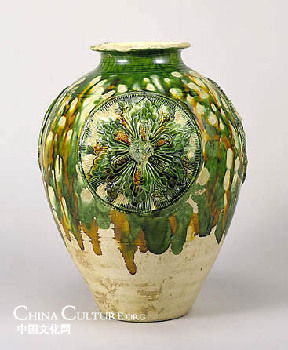 |
|
Tang Dynasty 7th-8th Century h.30.9cm |
The three baoxiang-hua medallions applied to the body of this jar stand out brilliantly under the fantastically mottled glaze, brown and green with white spots. The medallions were applied after press molding. The medallions on the “Bottle with Dragon Lugs, Three-Color Glaze,?an Important Cultural Property in the Yokogawa Collection of the Tokyo National Museum were made from a similar type of mold. This jar was covered with a white slip before glazing. The colorful glaze stops midway down the lower portion, achieving a delicate balance. The mouth and interior of the jar are glazed with a yellowish white glaze. A similar jar is in the Art Institute of Chicago, and a lidded jar which employs a slightly different glazing technique has been excavated at Jinjiagou, Luoyang, Henan Province.
BASIN: Porcelain with Carved Lotus Design
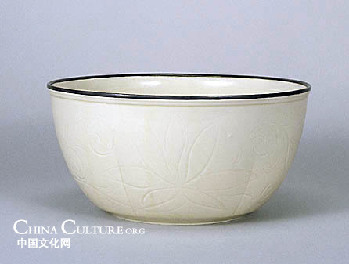
Ding Ware Northern Song Dynasty 11th Century d.24.5cm
This may appear to be a deep bowl, but the wide area of the base indicates that it is a basin. The lotus design is delicately carved, beveled and combed, to appear faintly against the ivory white surface which is unique to Ding ware. The pot is altered slightly with six vertical lines, making it melon-shaped. The clay is extremely fine, with almost no impurities, making it impossible for this pot to be thrown very thinly, and it is surprisingly light for its size. It did not warp in firing because it was fired upside down, and the glaze on the lip was later grimed. We can see the potter’s masterful touch in the beveled trimming around the base and the thin, low trimming work on the foot.
VASE: Stoneware with Sgraffito Decoration of Peony with Transparent Glaze under Green Glaz
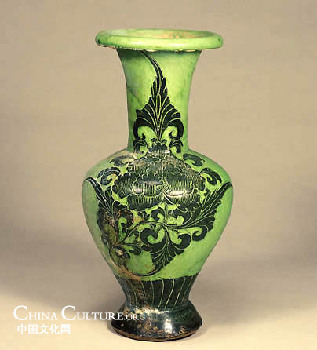
Cizhou Ware Northern Song Dynasty 11th-12th Century h.35.0cm
This vase was first formed out of a greyish clay and coated with a white slip. A second coating of iron pigment was applied, then its background was carved away to create a raised pattern. Then the entire vase was coated with a transparent glaze and fired. Up to this point, the vessel was made in the manner typical of Cizhou ware. However, this case is rare in that another coat of green glaze was added and fired again at a low temperature. The particular severity of the peony design that best reflects Northern Song aesthetics, as well as the exceptional size, has made this piece a valuable example noted worldwide.
BOTTLE: Porcelain with Incised Peony Scrolls Design Cut through Underglaze Iron-Coating
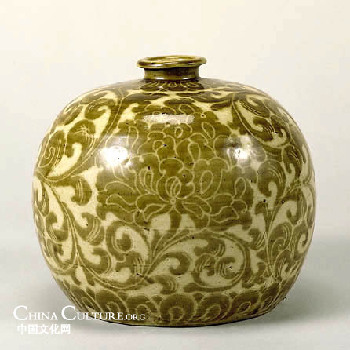
Ding Ware Northern Song Dynasty 11th-12th Century h.17.3cm
This shape is known as taibozun or tuluping. The white porcelain body was covered with an iron slip and then the design was carved away. The center of the form has a peony scroll design, while the shoulder and base are decorated with a double flower petal pattern. This form and decorative method were both also employed at the Cizhou kilns during the same period, the early 12th century, although there were differences in the use of white slip. This pot provides a good example for considering the relationship between the two wares. Other similar wares produced include small dishes, jars, and pillows, although compared to classic Ding ware, the clay has a slight gray tint and seems to be coarser.
BOTTLE: Celadon with Carved Peony Scrolls Design
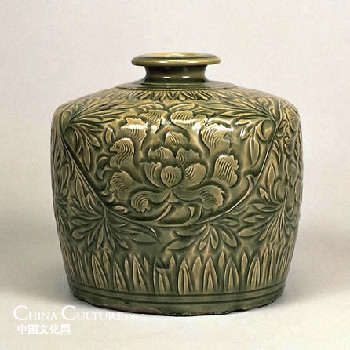
Yaozhou Ware Northern Song Dynasty 11th-12th Century h.16.7cm
Among the ceramic wares of the Northern Song Dynasty at its zenith, one finds Yaozhou ware. The kiln site for this ware has been discovered in Tongchuan, Shaanxi Province, north of Xi’an. The celadon glaze is often seen in an olive green color that is the result of oxidization during the firing process. It is also common to find a boldly-carved design covering most of the surface. The shape falls into the category of the tuluping, and at present it is the only one of its kind among Yaozhou celadon ware. The carving technique, called katakiribori in Japanese, leaves one side of the cut perpendicular to the surface and the other side with a slant. Here the celadon glaze fills the carved areas to create a beautiful feeling of depth befitting the worldwide fame of this piece.
TEA BOWL: Tenmoku Glaze with Leaf Design
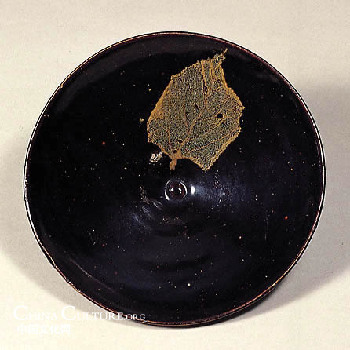
Jizhou Ware Southern Song Dynasty 12th Century d.14.7cm
Unlike the tenmoku tea bowl of the Jian ware, the tenmoku tea bowls of Jizhou have thinner walls because of the dense white clay, and have straight sides. The smallness of the foot is also another characteristic of Jizhou ware. Some Jizhou wares are known for the tortoise shell glaze created by coats of yellowish brown and black glazes. This piece shows an application of this glazing technique. However, the technique of actually using a leaf to leave an intricate imprint that even retains the pattern of the veins still remains unexplained.
Vase with Phoenix Handles Celadon
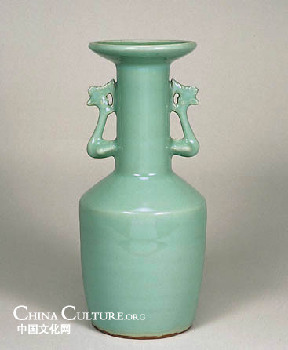
Longquan Ware Southern Song Dynasty 12th Century h.28.8cm
Commonly called the “vase with phoenix handles? this vessel is characterized by the mallet-shaped body and the attached phoenix-shaped handles. Many Chinese ceramic wares have survived since the Yuan Dynasty and the early Ming Dynasty, during and after which they were shipped in quantity to Japan. This particular vase, too, was handed down through an un-known number of generations of the Aoyama family of Tanba Province. Of the many extant phoenix-handled vases, one titled “ten thousand voices?and another called “one thousand voices?are especially famous for their beauty; this vase, however, surpasses even them with the unrivaled beauty of its glaze. It is believed to demonstrate the zenith of celadon ware production in the Longquan kilns of Zhejiang Province.
TEA BOWL: Tenmoku Glaze with Silvery Spots
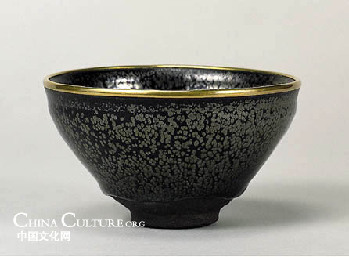
Jian Ware Southern Song Dynasty 12th-13th Century d.12.2cm
The Chinese describe this vessel type as dizhu, meaning beautiful drops, for the exquisite beauty created by myriads of iridescent “oil spots.?Jian tenmoku tea bowls were shipped in quantity to Japan during the Yuan Dynasty and the early Ming Dynasty. Among these wares, Tenmoku Glaze with Silvery Spots was prized the most. This tea bowl has long been considered an unrivaled piece of “oil spot?tenmoku.
BOTTLE: Celadon with Iron Brown Spots
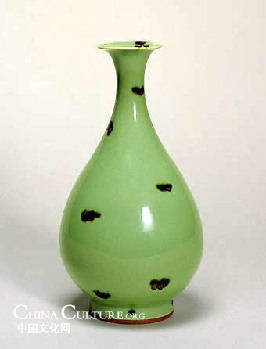
Longquan Ware Yuan Dynasty 13th-14th Century h.27.4cm
This bottle was decorated with iron spots and covered with a celadon glaze, a decorative method which was employed widely at the Longquan kilns in the Yuan Dynasty. This vase is particularly outstanding, both for the color of the glaze and the appearance of the iron spots. This type of form is popularly known as yuhuchun, pear-shaped bottle. The slender neck and full belly present a pleasing contrast, achieving a beautiful balance. The glaze has been scraped away from about five millimeters of the foot rim, revealing the clay body which has turned red in the fire.
DISH: Blue-and-White with Bird and Branch Design
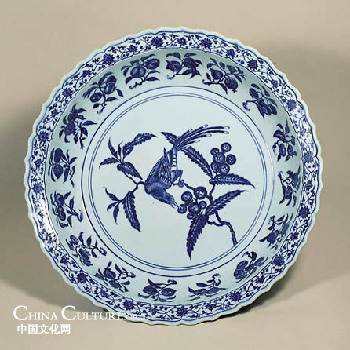
Jingdezhen Ware Ming Dynasty Yongle Period, 1403-1424 d.50.5cm
This large dish, with a diameter exceeding 50 centimeters, was made using a mold and then fired skillfully to obtain a non- warped form. A delicate floral scroll graces the foliated rim. The sides of the dish are divided into 16 sections containing pomegranate, peach and other auspicious fruits. In the center, a magpie eats berries on a branch. The composition is spacious, and the brush work is both decorous and elegant, making this a typical example of early Ming Dynasty pictorial design. Several other similar pieces are known to exist.
DISH: Porcelain with Reversed Peony Decoration against Cobalt-Blue Glaze
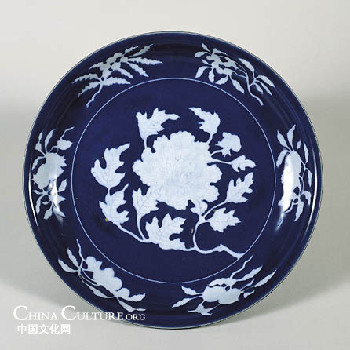
Jingdezhen Ware Ming Dynasty Xuande Mark and Period, 1426-1435 d.38.7cm
There is a large design of a peony branch in the center of this dish, and pomegranates, peaches, and litchi in six places around the rim. On the exterior there is a peony scroll pattern. The details of each pattern have been incised. This dish was probably decorated by applying a white slip to the decorated area, then glazing the rest with a blue glaze. The technique of decorating pots with a reverse white pattern against a blue background was already used in the Yuan Dynasty.
Porcellaneous Stoneware in Cloissone Style (Fuhua Ware) with Bird and Blossom Design

Ming Dynasty 15th Century h.44.5cm
According to records from the Qing Dynasty, the fahua technique was invented in the Yuan Dynasty in Shanxi Province, after which it spread to other areas. One theory traces the origin of this ware to three-color tiles which were made in Shanxi, while others point out the similarities to enameled bronze ware techniques which were perfected in the early Ming Dynasty; however, many points remain unclear. Extant fahua ware can be divided into porcellaneous ware and stoneware. Among the porcellaneous works, there are many large pieces, and it has been noted that there are similarities in form and decorative patterns between these and the blue-and-white ware and overglaze enameled ware of the Jingdezhen kilns. This jar is a rarely seen example of a large fahua porcellaneous jar. The design is applied in relief over a dark blue base, and the white areas strike a particularly beautiful contrast. Green glaze has been coarsely applied to the inside and the bottom of the jar.
COVERED JAR: Porcelain with Overglaze Yellow and Red Enamels; Dragon Design
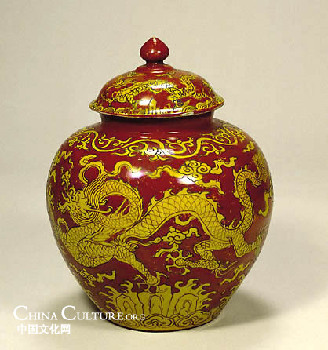
Jingdezhen Ware Ming Dynasty Jiajing Mark and Period, 1522-1566 h.27.0cm
Among zacai wares, this jar uses a particularly complex decorative technique. After first firing as porcelain, the entire surface was covered with yellow enamel and the jar was fired again. Then the design was applied and the piece fired a third time. In this case, the outline and details of the dragon design were painted in brown pigment, and the background filled in with red enamel. Due to the yellow base, the red color is even more vivid than usual. The design covering the jar’s surface combines with this vivid color for a rich effect. This jar is a good example of the mood of the Jiajing period, when colorful wares were popular.
Art
 more
moreArt Journey to the East
China and Japan have had a long relationship since the Han Dynasty.

[Photo] China National Opera House
Chinese soprano Wang Xia perfoms her part in the world

[Photo] Nannning International
Actresses perform acrobatics during a performance
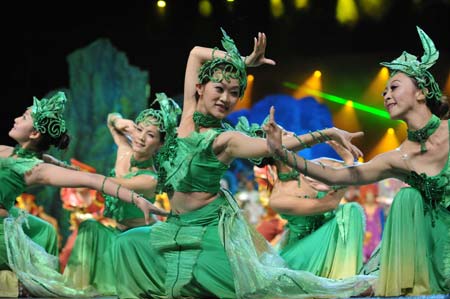
Customs
 more
moreChinese Kungfu
Everybody was kungfu fighting
Niels Tsai, a kungfu enthusiast from Malaysia, was halfway up misty
Tai chi helps cut pain of knee arthritis
The traditional Chinese form of exercise known as tai chi can help
Kungfu Taste: Learn Martial Art in Shaolin Temple
The mention of Shaolin Temple conjures up images of a quiet and




 print
print  email
email  Favorite
Favorite  Transtlate
Transtlate 